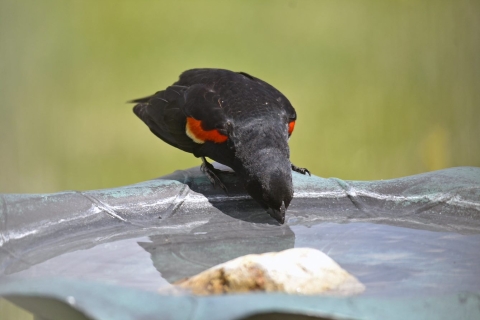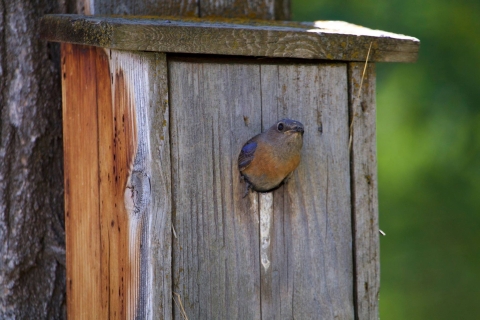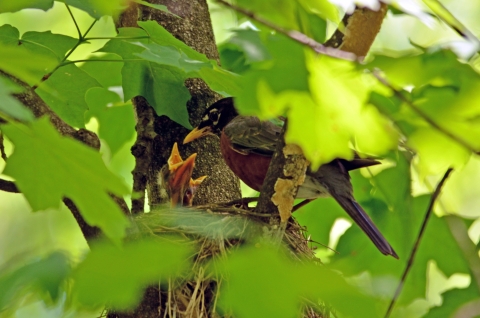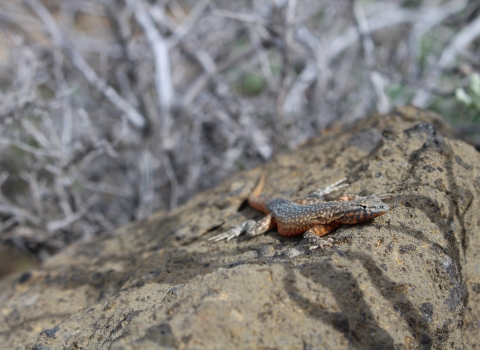Birds captivate all of us! Their beautiful songs, vibrant flashes of color, and the many important roles they play in our ecosystem make our world a better place. There are many easy ways you can help our feathered friends by making your home a safe and healthy home for them.
Install a Birdbath
All animals need water to survive, just like us! A birdbath provides fresh water to keep birds hydrated and cool during the hot summer months. You can even add some rocks to make it bee-friendly! Help prevent spreading disease by cleaning your birdbath often.
Build a Pond
Create a water feature in your yard to provide a home and drinking water for wildlife. While providing a valuable water source, you will also offer a breeding place for bugs like damselflies, which help control mosquitoes and also are a great food source for bats and birds.
Birds Need Homes Too!
You can help them find one. Visit your local nursery or backyard bird shop to learn about the best birdhouse for your local cavity nesters. Not all birdhouses are the same, so choose the right house for the species you want to attract. Make sure you prevent spreading disease by cleaning your birdhouses each year.
Leave Bushes and Branches
If nest builders are what you’re after, consider planting multiple layers of structure structure
Something temporarily or permanently constructed, built, or placed; and constructed of natural or manufactured parts including, but not limited to, a building, shed, cabin, porch, bridge, walkway, stair steps, sign, landing, platform, dock, rack, fence, telecommunication device, antennae, fish cleaning table, satellite dish/mount, or well head.
Learn more about structure and also letting branches and bushes grow out through the nesting season.
Feed the Birds
Feeding birds is an instantly gratifying way to invite wildlife into your backyard! Pay a visit to a local nursery or backyard bird shop to pick up a feeder designed for the birds in your area. Be sure to do your homework to see which feeder you need to attract your favorite birds! Help prevent spreading diseases by cleaning your feeder regularly.
Logs and Dead Snags
Both provide great habitat for all kinds of wildlife! Bats sleep during the day behind loose bark or inside cavities. Birds and small mammals find shelter inside cavities too. Insects, including pollinators, build nests in the dead wood or inside cavities which, in turn, feed birds. If well planned and maintained, they can also be a visually pleasing feature in your landscaping.
Make Your Windows Bird-safe!
Almost a billion birds die each year in the United States from window collisions! Here’s how you can help: -Move large houseplants away from windows where birds may mistake them for a garden -Place bird decals on the outside of your windows -Paint your windows with tempura paint – fun for kids and helpful to birds -Close the curtains at night or keep the lights down low to help night-migrators stay on track. Learn More: Preventing Collisions with Buildings and Glass
Leave a ‘Wild’ Zone
There’s no need to mow everything! One of the easiest and most cost-effective ways to create wildlife-friendly habitat is to leave sections of your lawn un-mowed and create a “wild” zone. Many animals use tall grass or a plant patch to hide and travel safely through your garden. Some birds build their nests in these zones. They also feast on the many bugs that live there. “Wild” areas don’t need to be unsightly; try planting some native grasses or wildflowers, adding a rock border, or, give it some character by placing a sign explaining to passersby why your garden is “wild.”
Plant Natives
Native plants are a beautiful and easily cared for garden addition! Their adaptations to the Northwest environment will save you money and effort on fertilizer, pest management, watering, and soil erosion. Native pollinators appreciate the familiar blooms, and animals like birds and small mammals love to feast on native berries late into the winter months. Many local nurseries work in partnership with backyard habitat certification programs to offer you discounts on native plants. Plant Natives: https://extension.oregonstate.edu/collection/native-plant- gardening
Landscape for All Four Seasons
Birds need food year round! Landscape in a way that provides birds with food during all four seasons. Plant a variety of bushes, trees, and plants that provide fruits, berries, seeds, nuts, and nectar throughout the year. Plant for Birds: https://www.audubon.org/PLANTSFORBIRDS
Leave Leaf Litter
In turn you will help bugs like worms and centipedes, and amphibians like frogs and salamanders, stay safe and happy. Birds love eating the many bugs that live in the leaves.
Landscape with a Rock or Wood Feature!
This cost-effective feature provides a home for bugs, reptiles (full sun), and amphibians (low sun and damp earth), as well as a food source for bug-eaters, including birds.
Keep Your Cat Indoors or Build a Catio
Outdoor cats are one of the biggest dangers to native wildlife! Free roaming cats kill billions of species around the world each year, and over 2.4 billion birds per year in the United States. Native wildlife, like coyotes and raccoons, can also put your feline in harm’s way. To protect native wildlife, and your beloved furry friend, keep your cat indoors, or build a protected catio.
Don’t Let Dogs Run Off-Leash
Keeping dogs on leashes is the best way of stopping them from chasing birds, which often causes our feathered friends to abandon their homes. It also helps migrating birds conserve their energy, which is necessary if they are to survive their journey.












